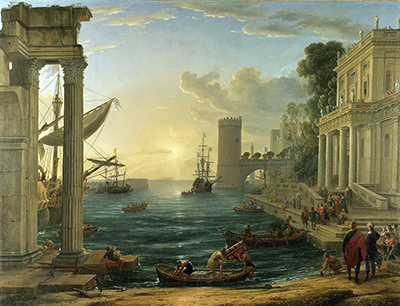JMW Turner studied many of the Old Masters in his ambition to become the most educated and knowledgeable artist possible, but it was specifically Claude Lorrain from whom he learnt the most.
Introduction to Claude Lorrain
Claude Lorrain was the critical link between the Renaissance, the Baroque, and then the rise of landscape art. He was taught in landscape painting in Italy and managed to change attitudes towards this genre. He struck upon a formula which drew in some highly prestigious commissions and allowed him to concentrate on his career throughout his lifetime. He would cover mythological and religious topics but in a manner which still allowed his landscape skills to take centrestage. For example, many of these different characters from old tales would be included as small figures within his foreground, only really visible to those specifically looking for them. He did not rate his own figurative skills particularly highly and so always focused more on showing off his impressive handling of the natural world, as well as a majestic use of light. It is particularly his use of light which would have interested Turner.
There are many similarities between Turner and Lorrain which jump out as you look into their careers. Lorrain liked to work outdoors around Rome and would regularly use pen and wash within his sketchbooks in order to capture various landscapes. He might work on other genres too, but the main body of work in these documented sketchbooks would always be of the outdoors. Turner famously left behind huge numbers of drawings, similarly stored within small sketchbooks that he himself would have taken on his travels. Turner travelled much more than Lorrain, but they were both knowledgeable on the variety to be found across the European continent. Lorrain travelled around Italy as well as to Germany and also back home to France at various points and would also converse with others who had travelled further afield in order to learn as much as he could about different locations. He had arrived in Italy as a young man after the death of his parents, receiving some early art guidance from his older brother before being accepted into several workshops.
Liber Studiorum (Book of Studies) and Liber Veritatis (Book of Truth)
Turner's Liber Studiorum (Book of Studies) represented his first work with printmaking and this publication was based on an earlier series by Claude Lorrain which was termed as Liber Veritatis. These were essentially a collection of prints and drawings of their major paintings and both would add information about these items as notes within the book itself. The similarities between these two projects were simply too great to mark this off as a coincidence. Turner took this idea and expanded it into a variety of different genres, taking in the likes of maritime, architecture and different types of landscape scenes. He used this approach to spread his reputation across the UK, with many people now able to purchase prints of his paintings for the first time. Lorrain's version consisted of prints from earlier pen and wash drawings which was a technique relatively similar to watercolour. Printed artworks had been used in many parts of Europe, including within the low countries where all levels of society liked to hang art upon their walls.
Influences upon JMW Turner
It would be wrong to only focus on the influence of Lorrain upon Turner, for he was someone who studied many styles and periods of art history in order to learn and develop as much as he could. Closer to his own period, for example, he is known to have taken ideas from the likes of Thomas Gainsborough, Henry Fuseli, Philippe Jacques de Loutherbourg, Michael Angelo Rooker and Richard Wilson. British art was started to impress and he found many notable collections around the UK from which he could study other domestic artists as well as masters from around Europe in previous centuries. Much has been written in the UK about Turner's sources of inspiration, as well as the ways in which he inspired others, such as members of the Impressionist movement in France. We do know that Turner burst into tears when viewing Claude's Seaport with the Embarkation of the Queen of Sheba from 1648 for the first time, and perhaps that dramatic episode has led to such a strong connection between the two being discussed as often as it has been. In reality, he would call upon a wide range of influences from all across Europe in order to become the extraordinary artist that he would eventually become.
Perhaps it was Lorrain's use of of light which so touched Turner when viewing his work in the UK. Much of the Frenchman's work was on show in the UK when Turner was a young man and he took every opportunity to see it in person. Claude Lorrain had an ability to stretch out a landscape, filling its content with beautiful detail from the near foreground to the far distance. He would also include a great control of light which would impact everything else in these complex but subtle scenes. His water would flicker with light, and Turner would also take on sunsets and sunrises which Claude himself had done a century earlier. Another important aspect was the way in which Claude would attempt to perfect nature, that is recreate what he saw whilst outdoors, but to then amend and improve upon it. This has a similarity to the Romanticists, who would go beyond just merely reproducing reality and attempt to incorporate their own emotions into each artwork. Claude was therefore signalling the importance of self expression, and showing them what was possible within this genre.




